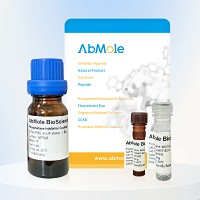All AbMole products are for research use only, cannot be used for human consumption.

Interleukin-15 (IL-15) is a 14-15 kDa glycoprotein with immune regulatory functions in many diverse cell types. As a pleiotropic cytokine, IL-15 mediates the crosstalk between innate immunity and adaptive immunity whose principal role is to kill virally infected cells. IL-15 plays a crucial role in the development, differentiation, and survival of NK cells. In monocytes, IL-15 induces the production of IL-8 and monocyte chemotactic protein 1 (MCP-1), which recruits neutrophils and monocytes to sites of infection. IL-15 can also act as a chemo-attractant in T lymphocytes and regulate the differentiation of T lymphocytes.
Measure by its ability to induce CTLL-2 cells proliferation, the ED50 for this effect is <10 ng/mL. The specific activity of recombinant mouse IL-15 is approximately >1x 105 IU/mg.
Sequence: NWIDVRYDLE KIESLIQSIH IDTTLYTDSD FHPSCKVTAM NCFLLELQVI LHEYSNMTLN ETVRNVLYLA NSTLSSNKNV AESGCKECEE LEEKTFTEFL QSFIRIVQMF INTS with polyhistidine tag at the N-terminus.
Accession: P48346
Apparent Molecular Weight: 17 kDa, reducing conditions
Endotoxin < 0.1 EU/µg
Lyophilized from a 0.2 μm filtered solution of PBS, pH 7.4.
| Form | Lyophilized powder |
| Solubility (25°C) | Reconstitute the lyophilized powder in distilled water to a concentration not less than 100 μg/mL. |
| Storage | Stored at ≤ -20°C, stable for one year after receipt. Reconstituted protein solution can be stored at 2-8°C for 2-7 days and at -20°C for 3 months. |
| Related Cytokines and Growth Factors Products |
|---|
| Recombinant Human GDF-15 Protein (HEK293 N-hFc)
Growth-differentiation factor 15 (GDF15), also known as MIC-1, is a secreted member of the transforming growth factor (TGF)-β superfamily. GDF-15 has a role in regulating inflammatory and apoptotic pathways in injured tissues and during disease processes. GDF-15 overexpression arising from an expanded erythroid compartment contributes to iron overload in thalassemia syndromes by inhibiting hepcidin expression. |
| Recombinant Human FGFR1 Protein (HEK293, C-His)
FGFR1, also known as CD331, is a full-length representative protein consists of an extracellular region, composed of three immunoglobulin-like domains, a single hydrophobic membrane-spanning segment and a cytoplasmic tyrosine kinase domain. |
| Recombinant Human FGFR2 Protein (HEK293, C-His)
FGFR2, also known as CD332, acts as cell-surface receptor for fibroblast growth factors and plays an essential role in the regulation of cell proliferation, differentiation, migration and apoptosis, and in the regulation of embryonic development. FGFR2 plays an essential role in the regulation of osteoblast differentiation, proliferation and apoptosis, and is required for normal skeleton development. It also promotes cell proliferation in keratinocytes and imature osteoblasts, but promotes apoptosis in differentiated osteoblasts. |
| Recombinant Mouse BMP-4 Protein (E. coli, C-His)
Bone Morphogenetic Protein-4 (BMP-4) is a critical signaling molecule required for the early differentiation of the embryo and establishing of a dorsal-ventral axis. BMP-4 is secreted from the dorsal portion of the notochord, and it acts in concert with sonic hedgehog to establish a dorsal-ventral axis for the differentiation of later structures. |
| Recombinant Human Coagulation Factor X (HEK293, C-Fc)
Coagulation factor X, belongs to the peptidase S1 family. Coagulation factor X is initially synthesized in the liver. Coagulation factor X is a vitamin K-dependent glycoprotein that converts prothrombin to thrombin in the presence of factor Va, calcium and phospholipid during blood clotting. |
All AbMole products are for research use only, cannot be used for human consumption or veterinary use. We do not provide products or services to individuals. Please comply with the intended use and do not use AbMole products for any other purpose.


Products are for research use only. Not for human use. We do not sell to patients.
© Copyright 2010-2024 AbMole BioScience. All Rights Reserved.
